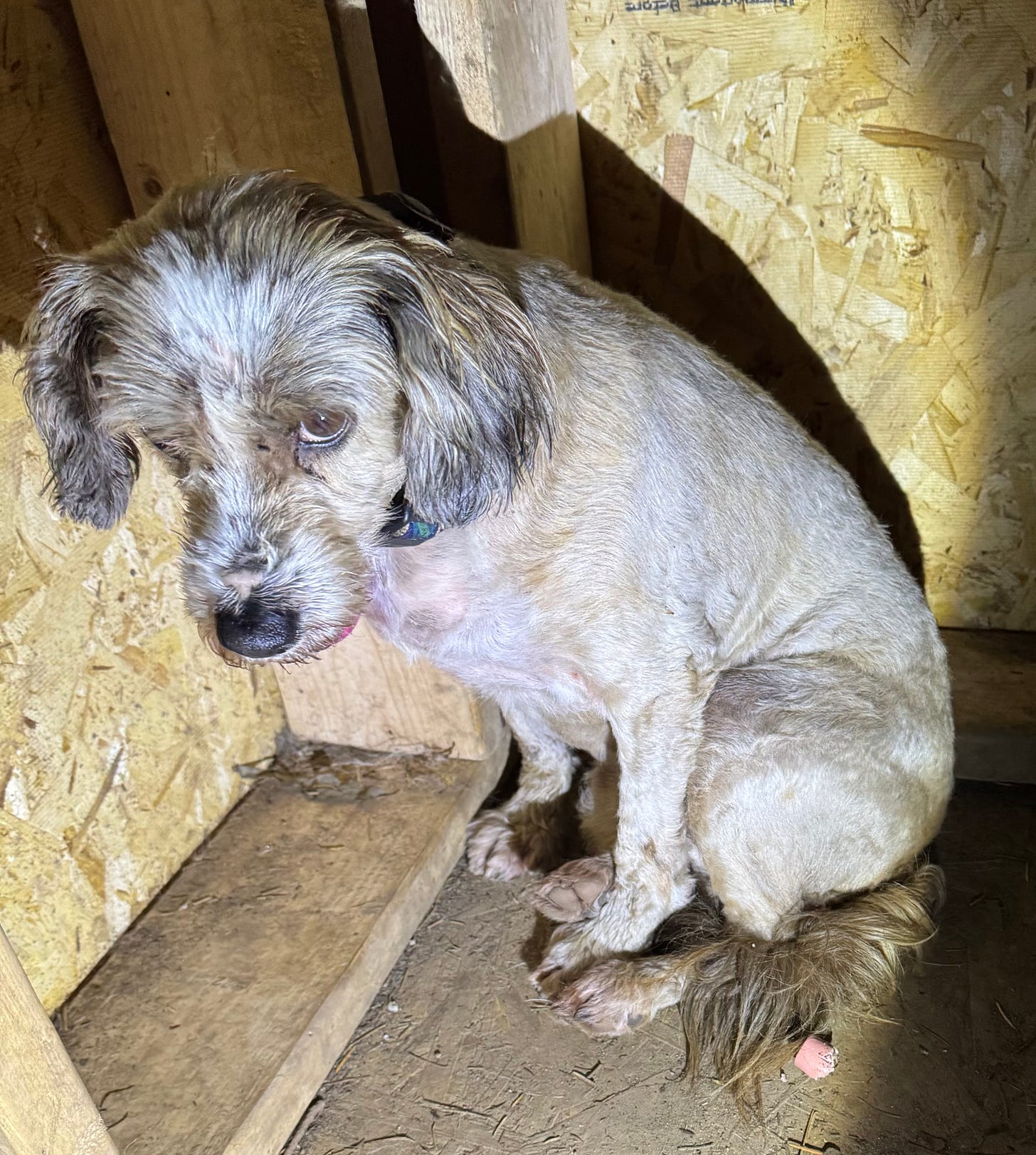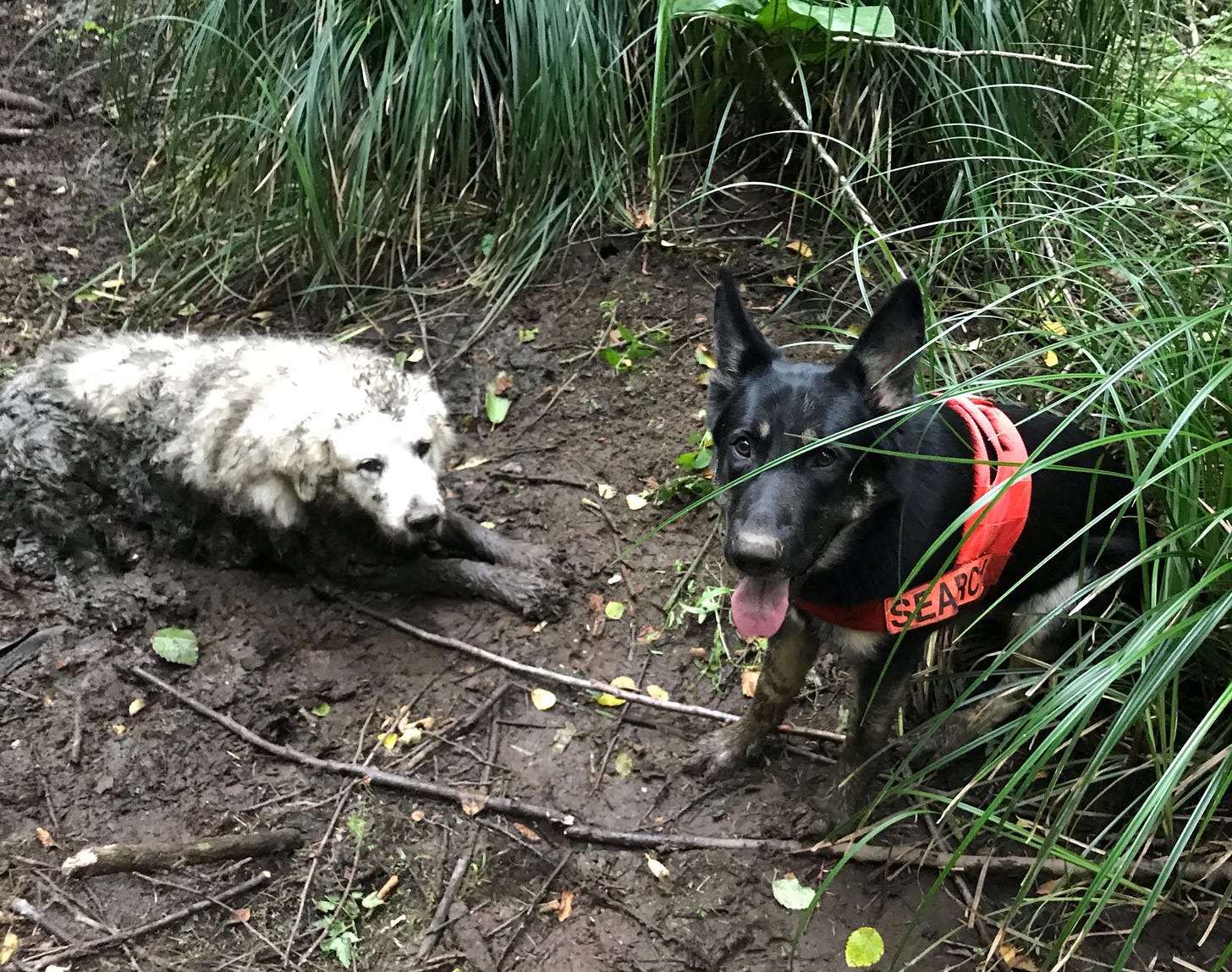Dorjee
Valentino has a success rate of finding the lost dog about 25% of the time. If he started right when a dog went missing, and if we weren’t blocked by encountering private property boundaries we couldn’t cross, he would have a success rate close to 100%. I believe it is theoretically possible that Tino could follow a “wrong” scent trail, but I don’t have any evidence that he has actually done so. If he ever did follow a wrong scent, I think the most likely reason would be a contaminated scent item. In dozens of searches, Tino has proven himself to be highly capable of following a scent, and I have never had any indication that he was wrong, even if we couldn’t catch up to the lost dog, for one reason or another. On November 20th, he led me to a particular spot, which he seemed very certain about, but I couldn’t see the lost dog anywhere. I didn’t doubt Tino, but it was a puzzle.
One of his greatest skills is the ability to pause the search and start again. This can be difficult for a search dog to learn. A good search dog wants to go, go, go. To be on the scent trail and to be told to wait can be very frustrating. It is common for us to run into some obstacle that requires us to pause the search. That Tino gets right back into the search is one of his best qualities.
When Tino found Dorjee on November 20th, the scent trail he tracked was only about 600 feet long, in total. However, the impressive part is that he followed this scent trail in four segments, having to wait up to half an hour between restarts.
Dorjee is a rescue dog who had just gone to a new foster home. She was very shy. She likes dogs, but is cautious about people. She had a wound from a scuffle with a dog in the previous foster home. At the new foster home, a door wasn’t latched fully, and the wind blew it open. Dorjee got out and ran off before her foster could get the door closed. Dorjee had an AirTag. By the time we went to search for her, her AirTag had pinged a few hours earlier, giving us a fresher starting point. We went to that location, and I knocked on the door to get permission for Tino to search in their yard. When I talked to the homeowner, they said they had actually seen Dorjee two hours earlier on the property behind them, on the other side of their fence. We drove around to that neighborhood. At the property where she was seen, no one answered the door, so we couldn’t get permission to search. It took over an hour to finally reach someone and get permission to search there. When Tino started searching, he tracked for about 200 feet to a break in the fence where it appeared Dorjee had passed through again going the other way. We drove around to the original place we had started. From the hole in the fence, Tino tracked to another yard, and we had to stop to get permission. Then he started tracking to a third yard, where we had to stop and get permission. Then to a fourth yard. At that point, Tino indicated the scent trail just stopped at a fence. It appeared Dorjee might have gone into a large farm field, although I didn’t see an obvious place where she could have gotten through the fence. Tino thought she was close, but we couldn’t see her.
I checked my iPhone, and the Find My app said Dorjee’s AirTag had registered near our location recently, about fifty feet away, direction unknown. I worked Tino around that area, but we couldn’t pick up the scent anywhere but the corner of that yard. The AirTag stopped communicating again. Ideally, I could have asked the app to locate the dog and my iPhone would direct me right to her, but the signal wasn’t strong enough for that. We only got one little blip saying she had been nearby recently. At that corner of that yard, one direction was a field with sheep and goats, and in the other direction was a fenced yard with a yellow lab and a husky. As we moved around, we got another ping from the AirTag, but it still wasn’t staying connected well enough for the Find My app to point us to it. Eventually, we got enough of a connection to be able to ask the AirTag to play a sound. At first, it seemed like the sound was coming from the field of farm animals. Then we tried it again and the sound seemed to come from the yard with the two large dogs. I didn’t see an obvious way into either yard, and obviously the dogs in the yard weren’t getting out, but I thought Dorjee could squeeze through some small gaps.
Then I saw Dorjee looking out of the doghouse of the two dogs. I just barely saw her eyes peeking around the corner. Tino had said she was nearby, but I just kept seeing the two dogs and the goats and sheep. It turned out that Tino was right. Dorjee likes dogs, and she had squeezed into a yard with two dogs, who fortunately turned out to be friendly to stray mutts seeking refuge.
It took us a while to contact that homeowner and explain that our lost dog had gone into their dogs’ doghouse. We finally got access, and the dogs’ owner took them inside so we could work. Using Calming Signals, I was able to get a leash on Dorjee and pick her up. She was safe.
Tino did great work, even though he didn’t cover a long distance with his tracking. Almost as important as Tino’s work was the AirTag. Apple AirTags have their limits. Apple does not recommend them for use in locating pets. Their range is only about fifty feet in the best of conditions. I have read articles about the limitations of AirTags, and I agree they are not ideal. In this case, the AirTag was critical. (Although, of course, an actual GPS tracker would have been better.) When we hit a dead end on the scent trail, if I had not picked up a ping from the AirTag, I probably would have tried to get permission from the farm field and started working Tino there. The yard with the dogs obviously had two large dogs in it, and I incorrectly assumed that Dorjee wasn’t in there, since I couldn’t see her. The ping of the AirTag made me keep looking there until I caught a glimpse of her in the doghouse.
Dorjee is the fourth pet whose AirTag was helpful in locating them, even if the limited range prevented us from finding the pet with the AirTag alone. When we were tracking one particular dog, a couple of years ago, we got a ping a mile away. We were able to jump over to the new location and start tracking, and Tino found the dog after following a short scent trail. In other cases, the last ping of the AirTag gave us a good starting point. If I thought one of my dogs was a risk to run away, I would give him an Apple AirTag and a GPS tracker such as Whistle. The GPS tracker can show you a pet’s location almost anywhere in the world, as long as the battery doesn’t die. One nice thing about the AirTag is that the battery lasts for a year, allowing the pet owner more time to pinpoint a location. In the case of Dorjee, we may have located her anyway, eventually, without the tracker, but it sure helped. I think the potential benefits of the AirTag outweigh the limitations.
I am always very proud of Tino, even when he is not able to locate the lost dog. His failure to locate a dog has never been his fault, as far as I am aware, but due to obstacles like private property lines. Tino has an enthusiasm for searching that doesn’t wane even when he is thwarted by challenges and obstacles. He had his first official walk-up find on July 21st, 2018, and he has probably been on about 250 searches in the past 6 years. He has saved the lives of dozens of dogs. I really love working with him, and he was instrumental in finding Dorjee, along with the AirTag. Certainly Tino is much more charismatic than a tracking device, and more fun to be around.







Great work! I was interested to hear about the limitations of AirTags as I recently saw someone encouraging people to place them on their horses should they get away from them went out riding. 50 feet doesn’t seem like it would do much good with a horse, but like you said, it could work as a complement to other methods.
Yeeeeeeeeah, Tino. Tino, the magnificent. Terrific Tino, Valentino the Valdedictorian? No matter which name you go by, yer awesome Tino!